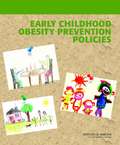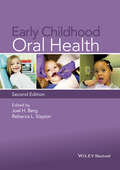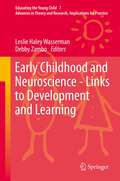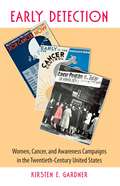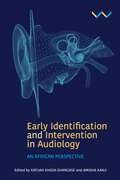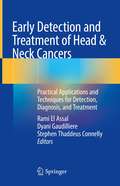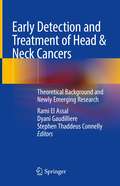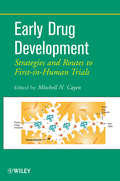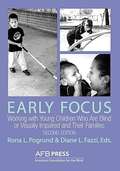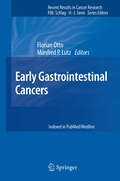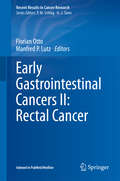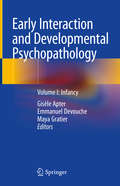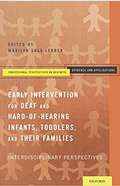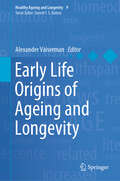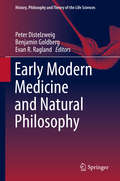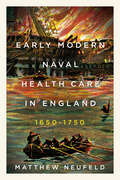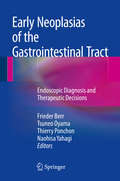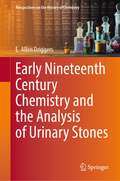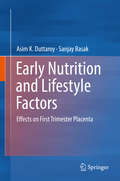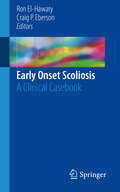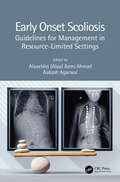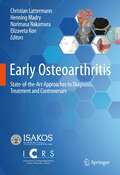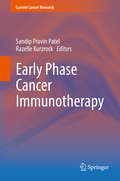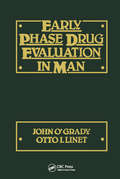- Table View
- List View
Early Childhood Obesity Prevention Policies
by The National Academy of SciencesBirch (human development and nutritional sciences, Pennsylvania State U. ) et al. present a report from the Institute of Medicine's Committee on Obesity Prevention Policies for Young Children that draws from reports from organizations, presentations, and other materials to review factors related to the prevention of overweight and obese children from birth to age five, with a focus on nutrition, physical activity, food and beverage marketing, reduction of TV screen time, healthy eating environments, access to affordable healthy foods, sleep, and sedentary behavior. They then suggest to policy makers and caregivers who interact with parents and young children policies that can change their environments to promote healthy weight and potential actions to implement them. Annotation ©2012 Book News, Inc. , Portland, OR (booknews. com)
Early Childhood Oral Health
by Rebecca L. Slayton Joel H. BergDental caries has been called a "silent epidemic" and is the most prevalent chronic disease affecting children. Though much has been written on the science and practice of managing this disease, publications are diverse in their loci, preventing easy access to the reader. Early Childhood Oral Health coalesces all the important information related to this topic in a comprehensive reference for students, academics, and practitioners.This second edition expands the scope of the first and puts an additional focus on interprofessional and global efforts that are necessary to manage the growing disease crisis and screening and risk assessment efforts that have expanded with the boom of new technologies. With updated references and incorporating the latest research, chapters address the biology and epidemiology of caries, the clinical management of early childhood caries, risk assessment, and early diagnosis. Other topics include public health approaches to managing caries worldwide, implementation of new caries prevention programs, fluoride regimens, and community programs, and family oral health education. Brand new are four chapters on the medical management of early childhood caries, considerations for children with special needs, interprofessional education and practice, and how the newest policy issues and the Affordable Care Act affect dental care.A must-read for pediatric dentists, cariologists, public health dentists, and students in these fields, Early Childhood Oral Health is also relevant for pediatricians and pediatric nursing specialists worldwide.
Early Childhood and Neuroscience - Links to Development and Learning
by Leslie Haley Wasserman Debby ZamboInformation from neuroscience is growing and being properly used, and misused wich makes it imperative that educators receive accurate and practical information. This book provides the accurate and practical information educators (pre-service and in-service) and caregivers serving children birth through age 8 need to know. This volume takes a practical and cautionary stance. It reminds educators to consider the ethical implications of neuroscience when it is applied to education, reviews current findings from neuroscience and reveals the dangers of oversimplification and inappropriate extensions of neuroscience into curricula. It brings together a group of authors with varied expertise writing on an array of inter-related educational topics that will help educators use neuroscience to understand and address the cognitive, emotional, social, and behavioral needs of all young children, including those with exceptionalities. They believe neuroscience can be insightful and useful to educators if applied ethically and with care. The book offers strategies educators and caregivers can use to affect children today and the adults they can become.
Early Detection
by Kirsten E. GardnerDispelling the common notion that American women became activists in the fight against female cancer only after the 1970s, Kirsten E. Gardner traces women's cancer education campaigns back to the early twentieth century. Focusing on breast cancer, but using research on cervical, ovarian, and uterine cancers as well, Gardner's examination of films, publications, health fairs, and archival materials shows that women have promoted early cancer detection since the inception of the American Society for the Control of Cancer in 1913. While informing female audiences about cancer risks, these early activists also laid the groundwork for the political advocacy and patient empowerment movements of recent decades.By the 1930s there were 300,000 members of the Women's Field Army working together with women's clubs. They held explicit discussions about the risks, detection, and incidence of cancer and, by mid-century, were offering advice about routine breast self-exams and annual Pap smears. The feminist health movement of the 1970s, Gardner explains, heralded a departure for female involvement in women's health activism. As before, women encouraged early detection, but they simultaneously demanded increased attention to gender and medical research, patient experiences, and causal factors. Our understanding of today's vibrant feminist health movement is enriched by Gardner's work recognizing women's roles in grassroots educational programs throughout the twentieth century and their creation of supportive networks that endure today.
Early Detection and Intervention in Audiology: An African perspective
by Katijah Khoza-Shangase, Amisha KanjiA textbook with case studies for audiologists and speech pathologists to make recommendations for early detection and intervention of hearing impairments in the South African contextEarly hearing detection and intervention (EHDI) is the gold standard for any practicing audiologist, and for families of infants and children with hearing impairment. EHDI programs aim to identify, diagnose and provide intervention to children with hearing impairment from as early as six months old (as well as those at risk for hearing impairment) to ensure they develop and achieve to their potential. Yet EHDI remains a significant challenge for Africa, and various initiatives are in place to address this gap in transferring policy into practice within the southern African context. The diversity of factors in the southern African context presents unique challenges to teaching and research in this field, which has prompted this book project. The South African government’s heightened focus on increasing access to health care which includes ongoing Early Childhood Development (ECD) programs, make this an opportune time for establishing and documenting evidence-based research for current undergraduate and postgraduate students. Early Detection and Intervention in Audiology: An African Perspective aims to address this opportunity. Grounded in an African context with detailed case studies, this book provides rich content that pays careful attention to contextual relevance and contextual responsiveness to both identification and intervention in hearing impairment. With diverse contributions from experts in local and international contexts, but always with an African perspective, this is textbook will be an invaluable resource for students, researchers and practitioners.
Early Detection and Treatment of Head & Neck Cancers: Practical Applications and Techniques for Detection, Diagnosis, and Treatment
by Rami El Assal Dyani Gaudilliere Stephen Thaddeus ConnellyHead and neck cancer (HNC) is a heterogeneous group of cancers that, if combined, represent one of the most common cancer types. Patients with HNC suffer significant morbidity and mortality due to the importance of the structures involved. Over two-thirds of these patients are diagnosed at a late stage, leading to a poor prognosis. Therefore, advancements in early detection and treatment of HNC are crucial. Volume I begins with a general overview, including the industry landscape, of HNC detection, diagnosis, and treatment. Next, it covers the applications of innovative technologies such as microfluidics, nanotechnology, and deep learning to early detect as well as study HNC. For example, studying the cellular features at a single-cell level became possible with the advancement of technologies such as mass cytometry or specifically, Cytometry by Time Of Flight Mass Spectrometry (CyTOF), which has revolutionized the way we can study complex human diseases such as HNC. Finally, the last few chapters are dedicated to describing the standard of care of HNC.The first volume of Early Detection and Treatment of Head & Neck Cancers is highly pertinent to the next generation of interdisciplinary clinicians, scientists, residents, and students who are particularly interested in HNC and in the translation of early detection methods, technologies, and research to clinical practice.
Early Detection and Treatment of Head & Neck Cancers: Theoretical Background and Newly Emerging Research
by Rami El Assal Dyani Gaudilliere Stephen Thaddeus ConnellyHead and neck cancer (HNC) is a heterogeneous group of cancers that, if combined, represent one of the most common cancer types. Patients with HNC suffer significant morbidity and mortality due to the importance of the structures involved. Over two-thirds of these patients are diagnosed at a late stage, leading to a poor prognosis. Therefore, advancements in early detection and treatment of HNC are crucial. This second volume provides an up-to-date overview of the theoretical background in the field of head and neck cancer (HNC) as well as of the emerging research that is impacting our understanding of this disease. The book begins with a comprehensive review of the epidemiology, etiology, symptoms, diagnosis, and staging of HNC. Next, it covers the essentials of potentially malignant disorders of the oral cavity, an important variety of HNC. Subsequently, it covers the newly emerging research in the field of HNC. The overall goal is to shift towards precision medicine (discussed in detail in Volume I), which will bring individualized clinical benefit to patients with HNC.This second volume of Early Detection and Treatment of Head & Neck Cancers concludes with the topic of chronic pain associated with HNC, including both the mechanisms of pain and the management strategies, and the emerging oral mucoadhesive drug delivery approach for HNC. All HNC surgeons, scientists, residents, and individuals whose lives have been touched by this disease, will recognize the impact pain has upon a patient’s health and his or her recovery trajectory.
Early Drug Development
by Mitchell N. CayenThe focus of early drug development has been the submission of an Investigational New Drug application to regulatory agencies. Early Drug Development: Strategies and Routes to First-in-Human Trials guides drug development organizations in preparing and submitting an Investigational New Drug (IND) application. By explaining the nuts and bolts of preclinical development activities and their interplay in effectively identifying successful clinical candidates, the book helps pharmaceutical scientists determine what types of discovery and preclinical research studies are needed in order to support a submission to regulatory agencies.
Early Focus: Working with Young Children Who Are Blind or Visually Impaired and Their Families (Second Edition)
by Diane L. Fazzi Rona L. PogrundThe second edition of Early Focus: Working With Young Children Who Are Blind or Visually Impaired and Their Families is a comprehensive resource on early childhood visual impairment. It addresses the needs of children who are blind or visually impaired from the age of birth to 5.
Early Gastrointestinal Cancers
by Florian Otto Manfred P. LutzThis Recent Results in Cancer Research volume contains the majority of the invited expert contributions from the First St. Gallen EORTC Gastrointestinal Cancer Conference, held on 22-24 March 2012 in St. Gallen, Switzerland. Written by some of the world's leading experts in the field, the volume constitutes a comprehensive update on recent developments in the imaging, molecular biology, pathology, and multidisciplinary management of early cancer of the gastrointestinal tract. The latest recommendations regarding diagnosis and treatment are provided, and areas of consensus and controversy, identified. While the principal focus is on esophageal and gastric cancer, advances in the treatment of colorectal and pancreatic cancer are also discussed in some detail. This book will be of interest to every clinician involved in the care of patients with gastrointestinal malignancies.
Early Gastrointestinal Cancers II: Rectal Cancer
by Florian Otto Manfred P. LutzThis Recent Results in Cancer Research volume provides an up-to-date overview of the multidisciplinary management of locally confined rectal cancer as well as colorectal cancer with synchronous resectable liver metastases. The contents comprise the majority of the invited contributions from the Second St. Gallen EORTC Gastrointestinal Cancer Conference, held on 6-8 March 2014 in St. Gallen, Switzerland. Written by some of the world's leading experts in the imaging, endoscopy, pathology, molecular biology, surgery, radiotherapy and medical oncology of rectal cancer and liver metastases, the chapters offer a comprehensive view on the latest recommendations in diagnosis and multidisciplinary treatment. Every clinician involved in the care of patients with rectal cancer will find this book interesting and helpful.
Early Interaction and Developmental Psychopathology: Volume I: Infancy
by Gisèle Apter Emmanuel Devouche Maya GratierThis first book of a two-volume series describes current research and state of the art clinical practice the shed light on the developmental origins of psychopathology in the first year of life, i.e. approximately up to the emergence of secondary intersubjectivity and/or walking. The second volume explores the interactional underpinnings of psychopathology in toddlerhood, from the time of voluntarily gross motor functioning to the emergence and basic organization of symbolic language at 24-30 months. A comprehensive approach is adopted, focusing on the fundamentally interactive nature of early development and examining interactions both with caregivers and more broadly with the socio-cultural environment. The books describe the processes involved in psychopathological trajectories and provide clinical insight into tailored, culturally sensitive therapeutic care in diverse environments. This volume discusses in detail situations placing the infant at risk and the nature of infant development, including communication, intersubjectivity, functional development, and affective and emotional development. Culturally and socially sensitive approaches to psychopathology are examined, with examples of specific infant- and family-centered therapies. Information on risk of abuse and neglect and infant protection policies is included.
Early Intervention For Deaf And Hard-of-hearing Infants, Toddlers, And Their Families: Interdisciplinary Perspectives
by Marilyn Sass-LehrerEarly Intervention for Deaf and Hard-of-Hearing Infants, Toddlers, and Their Families: Interdisciplinary Perspectives (Professional Perspectives On Deafness: Evidence and Applications) 1st Edition
Early Intervention in Psychiatry
by Peter Byrne Alan RosenEarly intervention (EI) is the single most important advance in mental health care in recent decades, representing a key shift in both theoretical standpoint and service delivery.Early Intervention in Psychiatry clearly describes best practice for extending this approach to all psychiatric disorders. Beginning with the rationale for EI, it informs interventions in people from all age groups across the lifespan, from perinatal to old age. It addresses EI in specific settings, such as primary health care, community health, the general hospital, non-government agencies, and in social movements, and for specific disorders including depression and anxiety, alcohol and substance use, childhood disorders, psychoses, bipolar disorders, eating disorders and borderline personality disorders.Early Intervention in Psychiatry is an essential guide for all psychiatrists, general practitioners, family physicians and public health doctors. It is also a valuable resource for mental health professionals and primary care colleagues, including nurses, social workers, psychologists, occupational therapists, vocational rehabilitation specialists, peer and support workers and for mental health commissioners and policy-makers.
Early Life Origins of Ageing and Longevity (Healthy Ageing and Longevity #9)
by Alexander VaisermanThis book provides a comprehensive overview of the field of developmental programming of ageing phenotypes. Although gerontological research has traditionally focused on later stages of the life cycle, growing evidence indicates that both the rate of ageing-associated functional declines, and the risks of later-life chronic pathological conditions, can be traced to origins early in life. While other books in the field concentrate on the developmental origin of particular disorders, this volume offers a detailed guide to all important aspects of the role of early-life conditions in programming both chronic pathological conditions and the ageing process.Interest in the study of ageing and longevity had its beginnings in research on the fetal origins of adult disease. This has evolved into a hypothesis on the Developmental Origins of Adult Health and Disease (DOHaD), which postulates that adverse environmental exposures during critical in-utero and early postnatal stages of development may permanently change physiological responses and cause functional impairments and disorders in adult life. In this book, the contributing authors and leading experts from around the world, describe research on mechanisms underlying the developmental programming phenomenon, as well as interventional strategies aimed at restoring developmentally disrupted epigenetic patterns. Early Life Origins of Ageing and Longevity benefits a wide audience of working scientists, clinicians, and advanced students, and will also interest scientifically curious general readers who wish to know more about current research in this rapidly evolving field.
Early Modern Medicine and Natural Philosophy
by Peter Distelzweig Benjamin Goldberg Evan R. RaglandThis volume presents an innovative look at early modern medicine and natural philosophy as historically interrelated developments. The individual chapters chart this interrelation in a variety of contexts, from the Humanists who drew on Hippocrates, Galen, and Aristotle to answer philosophical and medical questions, to medical debates on the limits and power of mechanism, and on to eighteenth-century controversies over medical materialism and 'atheism. ' The work presented here broadens our understanding of both philosophy and medicine in this period by illustrating the ways these disciplines were in deep theoretical and methodological dialogue and by demonstrating the importance of this dialogue for understanding their history. Taken together, these papers argue that to overlook the medical context of natural philosophy and the philosophical context of medicine is to overlook fundamentally important aspects of these intellectual endeavors.
Early Modern Naval Health Care in England, 1650–1750 (McGill-Queen's/AMS Healthcare Studies in the History of Medicine, Health, and Society)
by Matthew NeufeldFrom 1650 to 1750 the provision of medical care for injured seamen in the Royal Navy underwent a major transformation, shifting from care provided by civilians in private homes to care at hospitals run by the navy. Early Modern Naval Health Care in England examines the factors responsible for the emergence of centralized naval health care over the course of a century.In 1650 sick and injured Royal Navy sailors were billeted in homes in coastal communities where civilians were paid to look after them. Care work, which involved making meals and feeding patients, administering medicines, washing clothes and bed linens, and shaving and cutting hair, was essential to the recovery of tens of thousands of seamen – and it was done mostly by women. Beginning at the turn of the eighteenth century, naval health care moved to a more centralized system based in hospitals, where the conduct of sailors and care workers could be overseen. A key factor driving this change was the relationships between naval officials and female civilian caregivers, which were often fraught. Yet even with the shift to naval hospital settings, most care for convalescing sailors continued to be provided by women.Early Modern Naval Health Care in England shines a light on the care work that lay behind England’s formidable Royal Navy during the Age of Sail.
Early Neoplasias of the Gastrointestinal Tract
by Frieder Berr Tsuneo Oyama Thierry Ponchon Naohisa YahagiEarly Neoplasias of the Gastrointestinal Tract: Endoscopic Diagnosis and Therapeutic Decisions is an update of the current standards and newest skills in diagnostic endoscopy for neoplastic lesions of the upper and lower gastrointestinal tract. The volume defines strategies for detection and endoscopic assessment of small and minute early cancers and precursor lesions, including the endoscopic and endosonographic criteria for submucosal invasiveness. The book provides the knowledge in novel magnifying endoscopic analysis of early neoplasias fundamental to differential indication on snare mucosectomy, endoscopic submucosal dissection, or surgical/laparoscopic full-wall resection. Differential indications and contraindications for each technique are also specified. Comprehensive and authored by internationally renowned experts in the field, Early Neoplasias of the Gastrointestinal Tract: Endoscopic Diagnosis and Therapeutic Decisions is a valuable resource that will improve the diagnostic skills of beginners as well as experienced endoscopists in endoscopic submucosal dissection.
Early Nineteenth Century Chemistry and the Analysis of Urinary Stones (Perspectives on the History of Chemistry)
by E. Allen DriggersThis book tells the story of how chemists, physicians, and surgeons attempted to end the problem of urinary stones. From the late eighteenth to the early nineteenth centuries, chemists wanted to understand why the body formed urinary, pancreatic, and other bodily stones. Chemical analysis was an exciting new means of understanding these stones and researchers hoped of possibly preventing their formation entirely. Physicians and surgeons also hoped that, with improved chemical analysis, they would eventually identify substances that would reduce the size of stones, leading to their easier removal from the body. Urinary stones and other stones of the body caused the boundaries of surgery, chemistry, and medicine to blur. The problem of the stone was transformational and spurred collaboration between chemistry and medicine. Some radical physicians in America and Britain combined this nascent medical advancement with older disciplines, like humoral theory. Chemists, surgeons, and physicians in Charleston, Philadelphia, and London focused on the stones of the body. Chemical societies and museums also involved themselves in the problem of the stone. Meanwhile, institutions in Charleston, Philadelphia, and London served as repositories of specimens for testing and study as previously disparate practitioners and disciplines worked toward the comprehensive knowledge that could, perhaps, end suffering from stones. The primary audience of this book is historically-minded chemists, surgeons, physicians, and museum professionals.
Early Nutrition and Lifestyle Factors
by Asim K. Duttaroy Sanjay BasakThis book highlights the impact of nutrients on early placentation processes and their relevance for fetal growth and pregnancy outcome. The role of maternal nutrition on fetal growth and development has been evidenced in many epidemiological studies that included infamous Dutch famine, Helsinki Birth cohort and others. Fetal programming hypothesis states that the nutritional and other environmental conditions under which an individual develops from pre-conception to birth has a major impact on the future health of the newborn child. The developmental environment of the fetus is primarily dependent on two major factors that are maternal nutritional state (excess/low/imbalance) and placental function. Placentation is characterized by the extensive remodeling of the maternal uterine vasculature producing low-resistance blood vessels that facilitate the exchange of nutrients and wastes between the mother and the fetus. Cellular and molecular mechanisms involved in human placental blood vessel formation, which are now well established, are discussed.
Early Onset Scoliosis: A Clinical Casebook
by Craig P. Eberson Ron El-HawaryComprised exclusively of clinical cases demonstrating the management of idiopathic, congenital, syndromic and neuromuscular early onset scoliosis (EOS), this concise, practical casebook will provide orthopedic surgeons with the best real-world strategies to properly manage the differing presentations of EOS they may encounter. Each chapter is a case that opens with a unique clinical presentation, followed by a description of the diagnosis, assessment and management techniques used to treat it, as well as the case outcome, clinical pearls and pitfalls, and literature review. Cases included illustrate different types and management strategies for EOS, including various spine-based growing rods, the vertical expandable prosthetic titanium rib (VEPTR), anterior vertebral body tethering (AVBT) and congenital resection. Treatment strategies for EOS with related conditions such as myelomeningocele, cerebral palsy and skeletal dysplasia are also discussed, as are common complications and the role of traction.Pragmatic and reader-friendly, Early Onset Scoliosis: A Clinical Casebook is an excellent resource for pediatric orthopedic surgeons and other physicians confronted with both common and complex disorders of the child’s spine.
Early Onset Scoliosis: Guidelines for Management in Resource-Limited Settings
by Dr Alaaeldin Alaa Azmi Ahmad And Dr Aakash AgarwalThis book follows a context-based approach to management of early-onset scoliosis (EOS) in countries with limited resources in education, finance, and research. Due to the great variety in etiology, onset age, progression rate, and severity associated with EOS, it calls for a unique treatment plan. This book enumerates the optimal provision of surgical and non-surgical services, from education/training of local surgeons, to effective teamwork, to implementing an effective data collection system; helping the surgeon to gain a hands-on experience. It also illustrates the successful execution of deformity correction using real life experiences from countries in Asia, Africa, and Latin America. Key Features Discusses biomedical principles that will help to get universally standard implants that are credible and affordable for countries with limited resources. Specific surgical Guidelines and the ability to develop evidence-based practice for this service would be an interesting read for surgeons working in global organizations as well as to local surgeons. First book to focus on countries with limited resources for the management of early onset scoliosis.
Early Osteoarthritis: State-of-the-Art Approaches to Diagnosis, Treatment and Controversies
by Norimasa Nakamura Elizaveta Kon Christian Lattermann Henning MadryEarly osteoarthritis is novel topic for orthopedic surgeons and its process begins immediately after joint injury. The mechanical restoration of the joint surface or ligamentous stability is not sufficient to restore the homeostatic environment in the joint, and this leads to osteoarthritis, despite mechanical stability and alignment. This book sheds light on the various mechanisms and systems involved in the gradual decline of the injured joint toward manifest osteoarthritis.Published in collaboration with ISAKOS, this volume appeals to all stakeholders in surgical orthopaedics and sports medicine.
Early Phase Cancer Immunotherapy
by Razelle Kurzrock Sandip Pravin PatelThis volume, a state-of-the-art review of early phase clinical trials for cancer immunotherapy, discusses biomarker selection, combinatorial strategies and their safety or toxicity, determination of Phase 2 dosing, endpoints in the setting of radiographic pseudoprogression, histology selection, and novel immunotherapeutics as they relate to early phase cancer immunotherapy.
Early Phase Drug Evaluation in Man
by O'gradyEarly Phase Drug Evaluation in Man is a comprehensive, practical guide that covers pre-clinical information relevant to early human studies, including pharmaceutical, metabolic, toxicological, and regulatory aspects, as well as the general considerations relevant to all early human studies. Each major therapeutic area is considered by class of activity of drug. The chapters describe what measurements of drug activity are available in healthy human subjects and in patients, how to make the measurements, their value and their limitations. The contributors have been drawn internationally from the pharmaceutical industry and academia. Early Phase Drug Evaluation in Man will provide an important reference guide for industry and academic professionals involved in the development of new drugs.
